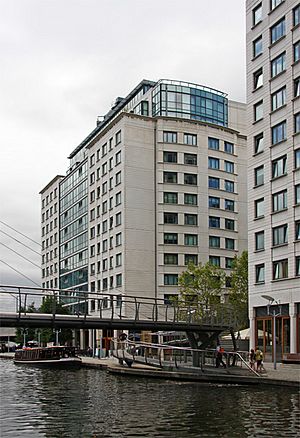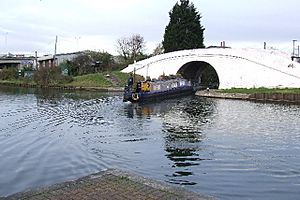Paddington Arm facts for kids
The Paddington Canal or Paddington Arm is a waterway that stretches about 13.5 miles (21.7 km) into central London, England. It starts in the west at a place called Bull's Bridge in Hayes. The canal connects to the Regent's Canal at Little Venice, which then goes all the way to Limehouse Basin in the east. Both the Paddington Arm and the Regent's Canal get their water from the Brent Reservoir. This canal is part of a very long, level stretch of water that is almost thirty miles long!
Contents
History of the Paddington Canal
Why the Canal Was Built
The idea for the Paddington Canal was approved by a special law in April 1795. This was during the time of the Industrial Revolution, when new factories and machines were changing how things were made. People wanted an easy way to move goods between different parts of England.
London had many special industries and received goods from all over the world. The Midlands region of England, on the other hand, was known for making many products like coal, bricks, wood, steel, and iron. The canal helped connect these two areas, making it easier to transport materials and finished goods. Later, the Regent's Canal was built, extending the waterway closer to the City of London and the River Thames.
Paddington Basin and Little Venice
The Paddington Canal officially opened on July 10, 1801. Reports say that 20,000 people came to see it! In 1801, Paddington was a small village, separated from the growing city of London by open fields.
In the early 1800s, the areas near the canal in Paddington were often used for collecting and moving London's waste. Huge piles of dust and ashes were common. However, by the mid-1800s, these waste areas were moved. Grand houses were then built along the canal banks. One famous person who lived there was the poet Robert Browning, from 1862 to 1887. Later, in the 1870s, a new sewer system designed by Joseph Bazalgette helped keep the area clean.
A Long, Level Waterway
The Paddington Arm is part of a very long "pound." In canal terms, a pound is a stretch of water that stays at the same level, meaning boats don't need to go through any locks. This amazing pound stretches from the Hampstead Road Lock in Camden all the way to Little Venice, and then along the entire Paddington Arm to Bulls Bridge.
It continues even further! South from Bulls Bridge to Norwood Top Lock, and north to Cowley Lock. Another branch, the Slough Arm, also connects to this same long pound.
This means a boat can travel a huge distance without changing water levels. You could go from Slough Basin, along the Slough Arm, then south on the Grand Union to Bulls Bridge, along the Paddington Arm through Little Venice, and finally along the Regent's Canal (through the Maida Hill Tunnel) to Hampstead Road Lock in Camden. All this without going through a single lock! This long stretch is about 27 miles (43 km) long.
Fun and Tourism
From the very beginning, the canal offered a fun way for Londoners to take a holiday in the countryside. People could rent a narrowboat and enjoy the peaceful waterways. Today, the Paddington Arm is still a popular place for tourists.
The canal also provides homes for many people who live on narrowboats in London. Organizations like the Canal & River Trust help manage and maintain the canals for everyone to enjoy.
Surrounding Areas and Parks

The end of the canal in London, called Paddington Basin, is now a modern area with tall buildings and public spaces. These buildings include offices, shops, and fancy apartments. You can also find the Queen Mother Wing of St Mary's Hospital and the main office for Marks & Spencer here. The canal stretch leading to Little Venice is also lined with shops and apartments at a place called Sheldon Square.
In other places, the canal runs alongside public parks. You can find parks near Greenford, Yeading, Northolt, and closer to the city at Meanwhile Gardens in North Kensington. The largest park next to the canal is Horsenden Hill in Sudbury.
The canal also forms one side of the long Kensal Green Cemetery. This is a very large, historic cemetery with many trees and interesting grave memorials. Famous people like Isambard Brunel are buried there. Next to it is St Mary's Roman Catholic Cemetery. These cemeteries have a wall along the canal bank for privacy. The path on the other side of the canal is called the towpath, and it offers great views of the waterway.




